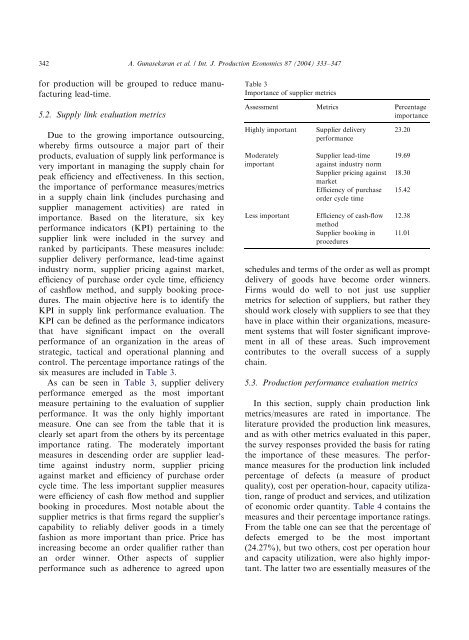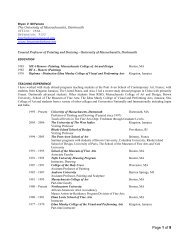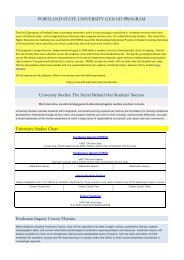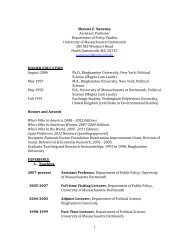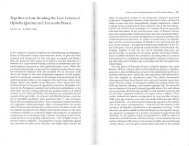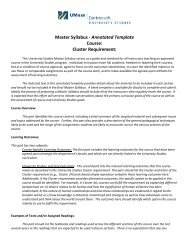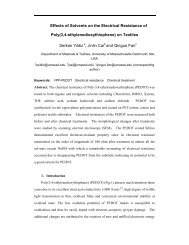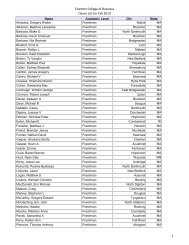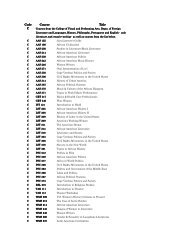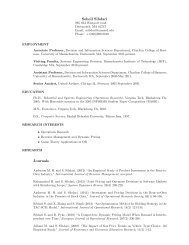A framework for supply chain performance measurement
A framework for supply chain performance measurement
A framework for supply chain performance measurement
You also want an ePaper? Increase the reach of your titles
YUMPU automatically turns print PDFs into web optimized ePapers that Google loves.
ARTICLE IN PRESS342A. Gunasekaran et al. / Int. J. Production Economics 87 (2004) 333–347<strong>for</strong> production will be grouped to reduce manufacturinglead-time.5.2. Supply link evaluation metricsDue to the growing importance outsourcing,whereby firms outsource a major part of theirproducts, evaluation of <strong>supply</strong> link per<strong>for</strong>mance isvery important in managing the <strong>supply</strong> <strong>chain</strong> <strong>for</strong>peak efficiency and effectiveness. In this section,the importance of per<strong>for</strong>mance measures/metricsin a <strong>supply</strong> <strong>chain</strong> link (includes purchasing andsupplier management activities) are rated inimportance. Based on the literature, six keyper<strong>for</strong>mance indicators (KPI) pertaining to thesupplier link were included in the survey andranked by participants. These measures include:supplier delivery per<strong>for</strong>mance, lead-time againstindustry norm, supplier pricing against market,efficiency of purchase order cycle time, efficiencyof cashflow method, and <strong>supply</strong> booking procedures.The main objective here is to identify theKPI in <strong>supply</strong> link per<strong>for</strong>mance evaluation. TheKPI can be defined as the per<strong>for</strong>mance indicatorsthat have significant impact on the overallper<strong>for</strong>mance of an organization in the areas ofstrategic, tacticaland operationalplanning andcontrol. The percentage importance ratings of thesix measures are included in Table 3.As can be seen in Table 3, supplier deliveryper<strong>for</strong>mance emerged as the most importantmeasure pertaining to the evaluation of supplierper<strong>for</strong>mance. It was the only highly importantmeasure. One can see from the table that it isclearly set apart from the others by its percentageimportance rating. The moderately importantmeasures in descending order are supplier leadtimeagainst industry norm, supplier pricingagainst market and efficiency of purchase ordercycle time. The less important supplier measureswere efficiency of cash flow method and supplierbooking in procedures. Most notable about thesupplier metrics is that firms regard the supplier’scapability to reliably deliver goods in a timelyfashion as more important than price. Price hasincreasing become an order qualifier rather thanan order winner. Other aspects of supplierper<strong>for</strong>mance such as adherence to agreed uponTable 3Importance of supplier metricsAssessment Metrics PercentageimportanceHighly importantModeratelyimportantLess importantSupplier deliveryper<strong>for</strong>manceSupplier lead-timeagainst industry normSupplier pricing againstmarketEfficiency of purchaseorder cycle timeEfficiency of cash-flowmethodSupplier booking inprocedures23.2019.6918.3015.4212.3811.01schedules and terms of the order as well as promptdelivery of goods have become order winners.Firms would do well to not just use suppliermetrics <strong>for</strong> selection of suppliers, but rather theyshould work closely with suppliers to see that theyhave in place within their organizations, <strong>measurement</strong>systems that will foster significant improvementin all of these areas. Such improvementcontributes to the overall success of a <strong>supply</strong><strong>chain</strong>.5.3. Production per<strong>for</strong>mance evaluation metricsIn this section, <strong>supply</strong> <strong>chain</strong> production linkmetrics/measures are rated in importance. Theliterature provided the production link measures,and as with other metrics evaluated in this paper,the survey responses provided the basis <strong>for</strong> ratingthe importance of these measures. The per<strong>for</strong>mancemeasures <strong>for</strong> the production link includedpercentage of defects (a measure of productquality), cost per operation-hour, capacity utilization,range of product and services, and utilizationof economic order quantity. Table 4 contains themeasures and their percentage importance ratings.From the table one can see that the percentage ofdefects emerged to be the most important(24.27%), but two others, cost per operation hourand capacity utilization, were also highly important.The latter two are essentially measures of the


